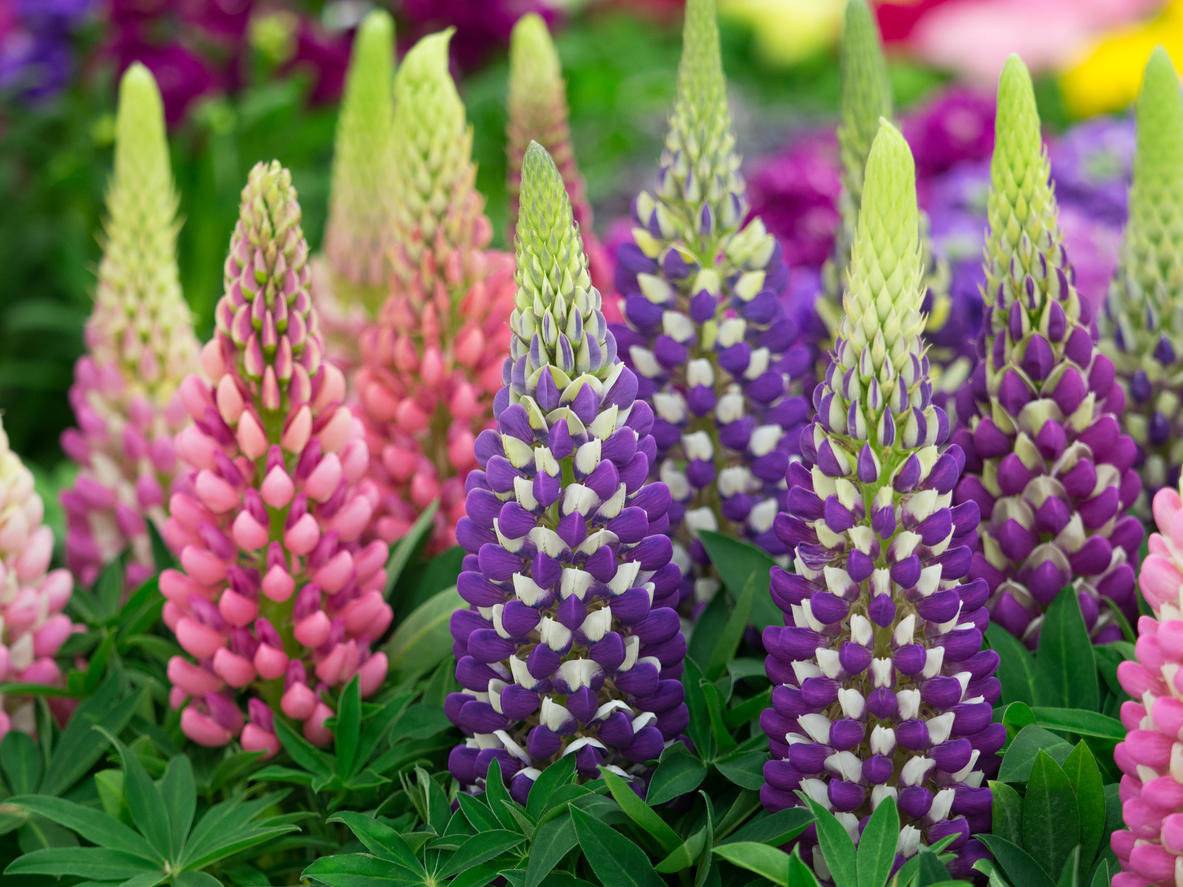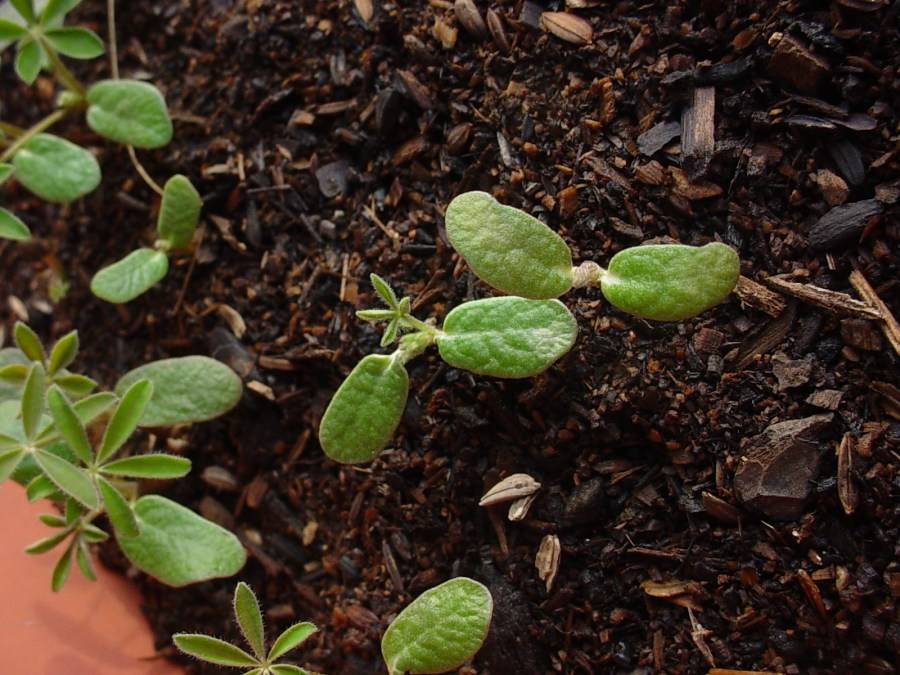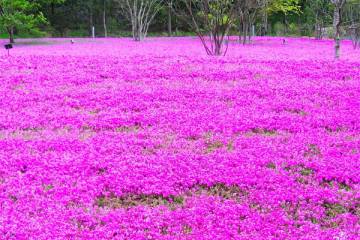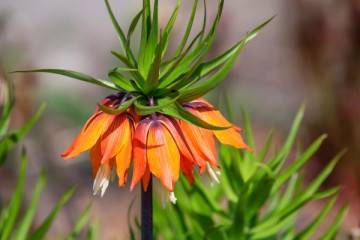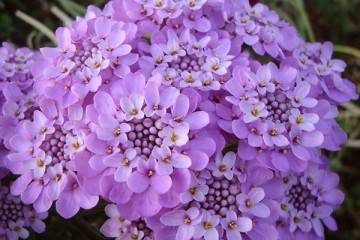Perennial lupine - when to plant seedlings
Content:
One of the brightest representatives of the legume family is lupine (Lupinus - "wolf" in Latin). Its natural habitat is the Mediterranean, the north of the African continent, the American deserts. Stony and sandy soils are favorable conditions for lupine. Below is how to grow a flower in Russia.
Botanical description
In Russia, 4 types of plants are bred, and the legume family has up to 800 species of culture. Flower description:
- plant on a herbaceous or woody stem up to 1.6 m high. Green stems can be either thin or thick, depending on the species. There are erect and branched;
- palmate leaves sit on long petioles. Foliage greens of varying intensity with a red or purple tint;
- the root system is strong, the main root extends to a depth of 2.5 m. The oval-elongated leaves can be small or large;
- flowers of various colors, and it changes with age. At the end, the flower can be light and dark;
- fruits - bivalve beans, which differ in size, shape in different species.
Briefly about the history of appearance
The history of lupine as a culture has more than 4 millennia. Seeds and empty beans were found in Egyptian tombs dating back to the XII Dynasty of Pharaohs (two thousand years before Christ).
Historians tend to believe that lupine as a culture was mastered by the ancient Peruvians. The museum of the city of Lima (Peru) contains a stone with drawings of the seeds and leaves of the plant. But the seeds found were larger than those of wild flowers.
The Egyptians, Greeks, Europeans domesticated lupines, based on the needs of society, in order to obtain green food, medicinal, etc.
The cultivation of the modern wolf bean has been influenced by the agricultural activities of man and science, due to which the biological properties have changed, some features of the wild plant have been lost.
Plant features
Lupine flowers are valuable not only as ornamental plants for decorating summer cottages. The plant enriches the land with nutrients, it is used as feed for livestock and poultry.
Its roots contain bacteria that can bind free nitrogen, which enriches the soil. Lupine seeds contain a lot of valuable protein, more than in all legumes, and green mass contains 10-12% fat.
White lupine is especially suitable as a valuable feed.
Is the plant poisonous
Seeds and shoots contain alkaloid substances (toxic and bitter). They have a detrimental effect on the nervous system, like nicotine.The ingress of toxic substances into the human or animal body causes paralysis of the respiratory organs. Poisons disrupt the functioning of the liver, because of which a person can even get cirrhosis. A person may die from severe poisoning with lupinide and glycoside.
Lupins - poisonous or not - a question that arises for novice gardeners. Most of the toxic substances are contained in seeds, a little in flowers. For a person to be poisoned, you will need to eat a handful of seeds and more than one flower.
Cut flowers look great in bouquets. When asked whether it is possible to put lupins at home, the answer is unequivocal - it is possible. Just don't keep the bouquet in the bedroom. It is advisable to hide from children and pets.
Description of perennial lupine species and characteristics of varieties
Of the variety of lupine species in Russia, only 4 are cultivated:
- narrow-leaved;
- yellow;
- white;
- perennial.
Perennial is not pretentious to growing conditions.
Summer bouquets are made from it, it has many varieties and types that differ in characteristics:
- the beginning of flowering: some bloom in the year of planting, others form inflorescences for a long time;
- by flowers;
- on the color of inflorescences.
There are especially many varieties among the hybrids bred by breeders: Yellow Flame, Aristocrat, Minaret, Scarlet Sails, etc.
Lupine narrow-leaved, or blue
An annual self-pollinating plant with a height of more than a meter. The name "blue" does not mean that the inflorescences are blue. They can be white, purple, pink. The seeds of the flower are interesting, they seem to be painted.
The plant is viable to habitat conditions, frost-resistant. The most common varieties of narrow-leaved lupine are:
- Snow;
- rainbow:
- Hope;
- Knight.
Lupine multifoliate
In the natural conditions of the Mediterranean climate, the USA, where the plant comes from, in the central regions of the Russian Plain, in Siberia and the Urals - everywhere lupine is comfortable.
The perennial has flowers with different colors. Loamy and sandy loam soils are favorable for the growth of many-leaved lupine.
Continuation of flowering in varieties is different. Russell has it in June and lasts no more than 3 weeks, the minaret blooms for a month.
Lupine yellow
Annual plant is medium-sized (up to 1 m).
It is rarely planted as an ornamental plant; the variety is more valuable as a fodder crop.
Especially popular:
- reliable;
- zhytomyr;
- Torch;
- Demidovsky.
Lupine white
Self-pollinating plant up to 200 cm high. Annual with bluish and pale blue inflorescences. It is thermophilic, therefore it prefers moist soil. Among legumes - the most productive crop.
Degas, Desnyansky, Gamma are popular varieties of white lupine.
Features of caring for lupines in the garden
The culture is unpretentious, but in order for the plant to show its full potential, it is necessary to follow the individual nuances of cultivation.
Lupine is a flower that needs lighting, because it is light-requiring. The plant will not survive a light shadow.
Watering
In order for the plant to develop quickly, it must be properly watered. Watering is especially important in the first year of active growth. The flower is watered abundantly, but the roots are not allowed to flood. They will get sick from dampness, the plant will die.
After watering, they thoroughly loosen, remove weeds, and also add soil under the bushes, protecting the root collar from strong winds and drafts.
By the second year, the number of waterings is reduced to 2 times a week if the weather is hot and dry.
Spraying
When lupine is cultivated for livestock feed on an industrial scale, it is sprayed with herbicidal preparations in order to prevent disease and plant death.
Humidity
Lupine is a plant that prefers a hot and dry climate, so you shouldn't spray it additionally. Waterlogging will have a detrimental effect on the health of the roots.
Priming
Fertile, well-drained, slightly acidic soils suitable for lupine. The plant does not bloom, and the foliage is faded if the ground is acidic. Lime is added before planting.
Top dressing
The wolf bean does not need nitrogen as it builds up on its own in the roots. The plant is fed in the spring with minerals: phosphorus, potassium before the formation of buds. The introduction of boron, molybdenum will strengthen the plant's immunity and protect against diseases. Boron enhances budding. In the flowering phase, a little organic fertilizer is applied to ripen the seeds.
Features of winter care
When the lupine begins to fade, the plant's life processes slow down.
Trimming dried elements
From the second half of October to the second decade of November, lupines are prepared for wintering:
- cut off yellowed, dried foliage;
- remove peduncles.
Hilling and preparing for winter
As the plant grows, its stem rises higher above the ground, which is why the root collar is exposed. Before covering the flower for the winter, sprinkle (sprinkle) the bare neck with earth.
And, although the wolf bean can easily endure mild frosts, caring gardeners cover it with spruce branches and straw. A thick layer of sawdust is poured under the bushes.
When and how it blooms
Blooming lupine looks gorgeous. The inflorescences are combined into one lush multi-flowered raceme. The flowers of the plant can have different shades, bright, elegant.
The flower cluster in some varieties is long, up to 100 cm, with a set of 60–80 buds, tightly pressed against each other. Others have many wide but short inflorescences.
Types of flowers
The varieties are distinguished by a variety of types:
- terry;
- smooth;
- semi-double.
Flower shapes
Lupine in bloom resembles multi-colored candles, someone sees an ear in the peduncle.
The plant has 5 petals per flower. The topmost one is larger, wider than the rest, is called a flag or sail. The side petals, two of them, are smaller in size, these are the wings. The lower ones are curved, fused at the base, these are boats.
The flower has a pistil with a stigma in the middle and 10 stamens.
Flowering period
The flowers of the wolf bean bloom in early summer, in June. Since the buds do not open all at once all together, flowering is long, lasts almost a month.
The peculiarity of the plant is that perennial lupine can bloom twice a year. Usually it blooms for the first time in the second half of June, the second - at the end of August.
Wild lupine, or field lupine, is distinguished by a long flowering. It got its name because it can grow everywhere: in the field, forest, along the roads. If this blue flower gets on the site, it is difficult to get rid of it.
Seed planting
The plant can be planted by direct sowing of seeds into the soil or by seedlings. For areas with frosty winters, it is advisable to plant seedlings so that the seeds do not freeze. Despite the fact that there are varieties of lupine that are resistant to frost, the risk still remains.
For seedlings, planting material is sown until March 10. The timing of planting lupine outdoors depends on the weather.
Features of this method
Autumn sowing has several advantages over spring sowing. During the summer, the soil warms up, and the seeds fall into a warm environment. During the wintering period, they will undergo a natural hardening procedure, which will increase germination.
From seeds of podzimny sowing, lupins will bloom in the same summer, and from spring seeds - in a year.
Seed planting lupine is simple, but new plants lose their parental characteristics. This happens more often with seeds harvested on their own.
Seed treatment (scarification)
Lupine seeds are very strong. Growers slightly damage the seed coat in order to facilitate germination. This procedure is called scarification and consists of several stages:
- Take sandpaper, rub the seeds, slightly scratching. Sometimes a sharp object is used. Then they are soaked for swelling.
- Arrange shock therapy for the seeds. First, it is wrapped in gauze and placed in the freezer. Having taken it out of the freezer, it is immersed in boiling water for 1 min. From such procedures, the seed bursts.
- Before planting, the seed is soaked in potassium permanganate or bleach. From a pipette, no more than 2 drops of a chlorine (10%) solution are instilled into a glass of water.
Soaking will save future plants from bacterial and fungal diseases.
The choice of container for seedlings
For seeding, cassettes, plastic cups or containers are suitable. The main requirement is the presence of drainage holes. Earth with peat and sand is poured into the container. The procedure for disinfection by calcining in the oven will not be superfluous.
Spill the soil with warm water and plant the seeds, slightly deepening. One seed is sown in glasses, several seeds are sown in containers with a distance of 6–7 cm. Cover with cellophane or glass. Place containers in a warm, lighted place.
Care of young plants
The sprouts will sprout for 15 days. The film is not removed immediately. Remove evaporating moisture, ventilate without creating drafts. Seedlings are watered with warm water, without flooding the plants and not drying out.
Half a month before planting on the site, the seedlings are hardened: they are taken out into the street, each time increasing the walking time.
Soil preparation
When the weather is warm, the soil warms up to 12 °, young lupins are transplanted to a permanent place.
The place is being prepared in the fall. The site is dug up, fertilizing with organic matter. Too acidic soil is deoxidized with dolomite flour, 3 kg are poured onto 1 m².
Before planting, the earth is dug up again.
Landing in open ground
With a transplant to a flower bed, they do not delay. Lupins have a rapidly developing root system. The roots are sensitive, so you need to carefully transplant seedlings from containers.
Pits are dug, at the bottom of which drainage is poured from expanded clay, broken brick and sand.
The holes are covered, watered, mulched, for example, with peat.
Terms of development and life of the plant
Lupine has several developmental phases:
- Germination. From swelling of seeds to germination of seedlings from the soil.
- Shoots. When cotyledons or own leaves appear.
- Stalking, or branching. Stem growth, formation of side shoots. At the same time, the number of flowers per plant is determined.
- Budding. In the axils of the leaves, on the tops of the shoots, buds are formed.
- Bloom. Petals begin to open from the lower flowers.
- Fruits are formed. The beans appear from the bottom up, like flowers.
- Maturation. Darkening of the fruit begins.
- Ripeness. 100% ripening of beans. All parts of the plant dry out, die off.
This is the life cycle of a lupine.
Propagation by cuttings
Often, novice gardeners ask how lupins multiply, except for seeds. Can be propagated by cuttings. At the same time, it is possible to grow flowers that have not lost varietal characteristics.
The stalk (growth bud) is located on a leaf rosette. How is the procedure going:
- Take an adult, but not an old plant.
- Cuttings are taken from root rosettes that form from the buds at the base of the plant.
- Cut off by grabbing a small part of the root.They are planted in a semi-shaded place.
In a month and a half, the seedlings will take root.
Possible problems in growing lupine
Sometimes gardeners are faced with problems in growing a wolf bean: diseases, insect attacks.
Lupine is a honey plant, but it attracts not only bees, but also pests that can completely destroy the culture.
Diseases
The plant is viable, but there are diseases against which lupine is powerless:
- fusarium;
- rust;
- root rot;
- mosaic virus.
Diseases at an early stage, when the foliage begins to turn yellow, are fought with fungicidal drugs, for example, phytosporin.
Pests
May beetle loves to lay larvae on young lupins. Thick caterpillars quickly eat up the plant. Aphids, moths, thrips, wireworms, weevils are flower lovers that can destroy the plant in a short time.
They are harvested by hand or sprayed with insecticides. Moreover, they are sprayed as soon as shoots appear.
Observing the simple rules of planting and caring for perennial lupins, many problems can be avoided.
Other problems
Experienced gardeners note some difficulties in growing, for example, transplanting lupine. It is advisable not to transplant the flower, since the long taproot is very easy to injure.
The plant is demanding on good soil. He needs a slightly acidic and slightly alkaline soil. Lightweight, loose, fertilized. On poor soils, the lupine will wither away.
Use in landscape design
Landscape designers often use lupine in their compositions. It is planted both in groups and singly. This simple flower looks luxurious and gives a festive look. They are planted with lawns, meadows, cover the unsightly places of the site.
The flower looks great among delphiniums, phloxes, irises.
Many gardeners believe that interest in the plant is increasing. And for good reason. Lupine is not only easy to grow and care for. He will decorate any site, enrich the land with nitrogen.
